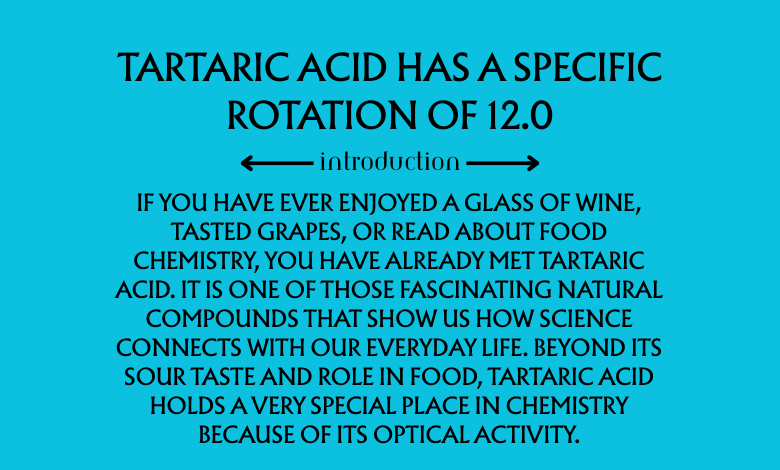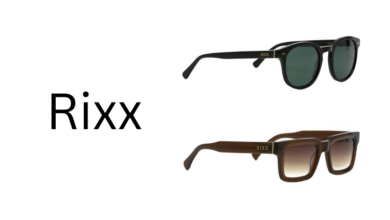Tartaric acid has a specific rotation of 12.0

If you have ever enjoyed a glass of wine, tasted grapes, or read about food chemistry, you have already met tartaric acid. It is one of those fascinating natural compounds that show us how science connects with our everyday life. Beyond its sour taste and role in food, tartaric acid holds a very special place in chemistry because of its optical activity. In fact, chemists note that tartaric acid has a specific rotation of +12.0, and that small number carries a huge amount of meaning in stereochemistry, chirality, and even the history of science itself.
When I first came across the concept of specific rotation in university, it felt abstract. Why should the way light rotates in a solution matter? But then I learned about Louis Pasteur’s experiments with tartaric acid crystals, and suddenly the subject came alive. Optical activity is not just numbers and formulas. It is a window into how molecules exist in three-dimensional space and why living systems are built the way they are.
Let’s take a deep dive into tartaric acid, its specific rotation, and why this small molecule has had such a big impact.
What is Tartaric Acid?
Tartaric acid is an organic acid found naturally in grapes, bananas, tamarinds, and wine. Chemically, it is a dicarboxylic acid with two hydroxyl groups, making it both acidic and polar. Its molecular formula is C4H6O6, and what makes it truly fascinating is its stereochemistry.
Unlike many acids, tartaric acid has multiple stereoisomers. That means the same formula can be arranged in different three-dimensional ways. Some of these versions rotate light, while others cancel each other out. This is why tartaric acid became one of the first molecules that revealed the mystery of chirality to chemists.
In everyday life, tartaric acid plays important roles. It adds tartness to foods, stabilizes wine during fermentation, and is used in baking powders as a leavening agent. In medicine, it can be found in certain drugs as a stabilizer. But in chemistry, its deeper importance lies in its optical activity.
Understanding Specific Rotation
So what does it mean that tartaric acid has a specific rotation of +12.0?
Specific rotation is a measurement of how much a chiral substance can rotate plane-polarized light. If you shine polarized light through a solution of tartaric acid, the plane of light will rotate. The amount of rotation depends on the molecule’s chirality, concentration, temperature, and wavelength of light used.
The formula for specific rotation is:
[α]=αl⋅c[\alpha] = \frac{\alpha}{l \cdot c}
Where:
-
[α][\alpha] = specific rotation
-
α\alpha = observed rotation (in degrees)
-
ll = path length in decimeters
-
cc = concentration of solution in g/mL
For tartaric acid, the specific rotation is +12.0 degrees, which tells us three things:
-
It is optically active.
-
The positive sign means it is dextrorotatory (rotates light to the right).
-
Its optical activity is moderate compared to some strongly rotating compounds.
When I first measured optical rotation in a polarimetry lab, the value seemed small, but I quickly realized that these numbers are precise fingerprints of molecules. A few degrees of rotation can mean the difference between one enantiomer being a vitamin and the other being inactive or even harmful.
Read Also: Who is Keba Seemo: An In-Depth Look at the Life, Art, and Vision
Chirality and Optical Activity
Chirality is a word that comes from the Greek word for “hand.” Just as our left and right hands are mirror images but not identical, chiral molecules exist in pairs called enantiomers. They look similar but are not superimposable.
Tartaric acid is one of the classic examples of chirality in chemistry. It has two stereocenters, which means there are different possible arrangements of its atoms. These include:
-
D-(+)-tartaric acid: dextrorotatory, with a specific rotation of +12.0
-
L-(–)-tartaric acid: levorotatory, with a specific rotation of –12.0
-
Meso-tartaric acid: optically inactive because the rotations cancel each other out
This is why tartaric acid is such a valuable teaching tool. Students can actually see how the same formula can create molecules with very different properties.
Measuring Optical Rotation
The instrument used to measure optical activity is called a polarimeter. The process is simple in concept but requires care in practice.
-
Plane-polarized light is passed through a tube containing the solution of tartaric acid.
-
The angle of rotation is measured relative to the original orientation of the light.
-
This observed rotation is then corrected using the path length and concentration to calculate the specific rotation.
In standard conditions, tartaric acid solutions give a specific rotation of +12.0. However, this value can shift slightly depending on the wavelength of light, the solvent, or the temperature.
When I first used a polarimeter, adjusting the eyepiece to find that exact balance point felt like solving a puzzle. It was a reminder that even something as abstract as chirality can be directly observed if you have the right tools.
Stereochemistry of Tartaric Acid
Let’s break down the stereoisomers of tartaric acid:
-
D-(+)-tartaric acid: Rotates plane-polarized light to the right (+12.0). Found naturally in grapes and wine.
-
L-(–)-tartaric acid: Rotates light to the left (–12.0). Less common in nature.
-
Meso-tartaric acid: Despite having stereocenters, it is achiral due to internal symmetry. It does not rotate light.
The existence of a meso form is particularly fascinating. It shows that not all molecules with stereocenters are chiral. When I first saw this in class, it was a “lightbulb moment.” Chemistry isn’t always intuitive, but once you see the symmetry, it makes sense.
Applications of Tartaric Acid
Beyond chemistry labs, tartaric acid plays important roles in industry:
-
Food and Beverage: It gives grapes and wine their tartness, prevents crystallization, and stabilizes color.
-
Pharmaceuticals: Used in effervescent tablets and as a stabilizing agent.
-
Industrial Uses: Employed in tanning, ceramics, and even silvering mirrors.
-
Analytical Chemistry: Its enantiomers help separate chiral compounds.
This is one of those molecules where science and daily life meet. Next time you drink wine, you can thank tartaric acid not only for the flavor but also for inspiring discoveries in stereochemistry.
Historical Perspective: Pasteur’s Discovery
In the mid-1800s, Louis Pasteur made a breakthrough when studying tartaric acid. He noticed that some crystals rotated light while others did not. By carefully separating crystal forms under a microscope, he discovered enantiomers.
This was the first demonstration of molecular chirality, and it set the stage for modern stereochemistry. Today, the pharmaceutical industry relies heavily on this concept because one enantiomer of a drug can be therapeutic while the other may be inactive or harmful.
Why Does This Matter Today?
Understanding tartaric acid and its specific rotation of +12.0 is not just academic. It shows us how molecules interact with light, why chirality matters in biology, and how chemistry influences the foods and medicines we consume.
I remember struggling with stereochemistry until I connected it with real examples. Seeing tartaric acid crystals, learning about Pasteur’s work, and then tasting the sourness in grapes made the subject real. That is why teaching through molecules like tartaric acid works so well.
Conclusion
Tartaric acid is more than just a sour compound in grapes. Its specific rotation of +12.0 reveals the deeper science of chirality and stereochemistry. From Pasteur’s discovery to modern pharmaceutical applications, it continues to be a molecule that bridges history, chemistry, and daily life.
FAQ
Q1: What is the specific rotation of tartaric acid?
The specific rotation of tartaric acid is +12.0 under standard conditions, which means it rotates plane-polarized light to the right.
Q2: Why is meso-tartaric acid optically inactive?
Meso-tartaric acid has internal symmetry that cancels out its optical activity, making it achiral even though it has stereocenters.
Q3: How is specific rotation measured?
It is measured with a polarimeter, using polarized light passed through a solution. The observed rotation is then standardized to path length and concentration.
Q4: What industries use tartaric acid?
It is used in food, wine, pharmaceuticals, ceramics, tanning, and analytical chemistry.



